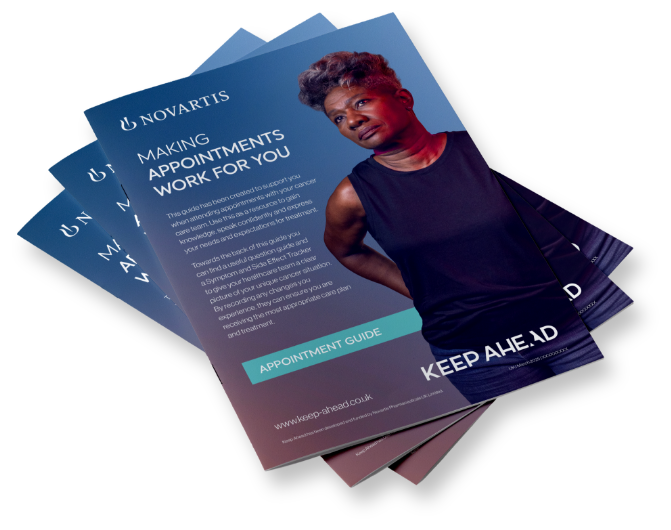Treatment
Treatment is essential to help removing cancer, reducing risk of recurrence and managing life in remission
It looks like you are using an older version of Internet Explorer which is not supported. We advise that you update your browser to the latest version of Microsoft Edge, or consider using other browsers such as Chrome, Firefox or Safari.
Keep Ahead has been developed and funded by Novartis Pharmaceuticals UK Limited. This site is intended for UK early breast cancer patients and general public.
Treatment is essential to help removing cancer, reducing risk of recurrence and managing life in remission
Even after initial breast cancer treatment, it’s important to understand that the available treatment options are given to reduce the risk of cancer returning. Each treatment decision is a step towards a brighter and healthier future, and we’re here with you to guide and support you on your treatment journey.

Your specialist care team will explain the treatments, their associated benefits and side effects, and they will work alongside you to create a treatment plan that works best for you.2
Depending on the specifics of your cancer, your oncologist may recommend a variety of treatments. If you have received treatment for breast cancer before, you and your doctor will take your previous treatments into consideration when deciding on a treatment plan.1
Surgery can be offered for numerous reasons. You might be offered a mastectomy, to remove the breast or breasts affected by the cancerous cells. Surgery can also be used to remove affected lymph nodes.3,4 Most find they will begin their treatment with surgery, however sometimes treatment begins with chemotherapy or hormonal therapy before surgery is carried out.4
Different types of surgery:
Lumpectomy
Depending on the size and position of the cancer, you might be able to have just the cancer and a border of normal breast tissue removed. This is also called breast conserving surgery or wide local excision.4
Mastectomy
Your surgeon may recommend you have the whole breast removed if the cancer is in a large area of the breast. Breast reconstruction is an option at the time of surgery or later if recommended.4
Surgery to the lymph nodes
Cancer cells can sometimes break away from the breast tissue and go to other parts of the body. If this happens, it usually first spreads to the lymph glands (nodes) in the armpit close to the breast.4
If your breast cancer was oestrogen receptor-positive, hormone therapy can help by blocking oestrogen or reducing its production, which may lower the risk of recurrence.2,3
Hormone therapy uses medicines to either:
Hormone therapy may be used:
Low adherence to adjuvant therapy can increase the risk of cancer returning,5 therefore it is crucial you understand that these side effects are often caused by primary therapy which can impact quality of life and adherence to adjuvant treatment. Understanding the source of these symptoms allows for better management strategies and supports informed decisions about ongoing care.
Targeted therapies are a group of drugs which aim to block cancer from growing and spreading. Patients with cancers may continue targeted therapy to minimise the risk of recurrence, by targeting and interfering with the cancer cells’ growth process. Your specific recurrence will determine which targeted therapy you are offered.3,4
If you had breast-conserving surgery (lumpectomy), radiation therapy may be necessary to target any remaining cancer cells in the breast area. This can be offered if surgery isn’t an option for your personal situation.3,4
Drugs that are used to help strengthen your bones and prevent or slow down the development of bone thinning. They also reduce the risk of cancer spreading to the bones, especially in post-menopausal patients.4
The primary goal of further treatment after your initial clinical intervention (i.e. surgery) is to reduce the likelihood of your cancer returning. Post-treatment therapies are given to lower the risk of recurrence and aim to allow for a healthy future. These treatments are known as adjuvant therapies, which target any remaining cancer cells that may not have been removed during surgery, or other breast cancer treatments.1

It can be difficult to continue taking medication or attending treatment sessions after the main cancer treatment is over, but adhering to your treatment plan is crucial for reducing the risk of recurrence. Missing doses or stopping treatment early can lessen the effectiveness of therapies, making it more likely that the cancer could return. Talk with your medical team if you have concerns about side effects or treatment fatigue. Depending on your circumstances, they may be able to suggest adjustments to make things easier for you.
Most treatments come with side effects, but with help from your healthcare team, there are ways to manage them so that they don’t interfere too much with your daily life. Some common side effects include:

Fatigue

Hot flushes

Nausea

Joint pain

Bone thinning
Tracking side effects is crucial for effective management. By noting their severity and frequency, you can provide your healthcare team with valuable insights that can guide treatment adjustments and improve your overall care. Keeping a detailed record helps identify patterns, assess medication effectiveness, and prevent complications.
Your healthcare team can also work with you to find strategies for minimising these effects. Simple lifestyle changes, such as staying physically active or adjusting your diet, can make a big difference. Medications to manage specific symptoms are also available.
With proper management of side effects and balanced lifestyle, many people still find that they can enjoy the activities they love.
For tips and advice on living with remission click the link below.

If you are experiencing any negative impacts of side effects from treatment, download the Keep Ahead Appointment Guide. It can help you to track your side effects and symptoms and even has tips on how to discuss them with your healthcare professional at your next appointment.
Your care extends beyond one doctor — it’s supported by a dedicated multidisciplinary team, focused on treating your cancer and guiding you through your journey. Your team might include oncologists, surgeons, radiologists, nurses, nutritionists, and counsellors. Learn more about your team here.
These professionals work together to ensure that every aspect of your health is considered, from physical symptoms to mental health and emotional wellbeing. Don’t hesitate to ask questions or express concerns. Frequent open communication with your team is crucial for adapting your treatment plan so that it fits your individual needs.
Make sure you’re ready for your next appointment, by downloading our appointment guide.


Please fill in your answers below.

References:
UK | September 2025 | FA-11300409-1

Terms of use | Cookies and Data Privacy | Cookie Settings
Keep Ahead has been developed and funded by Novartis Pharmaceuticals UK Limited. It has been created in collaboration with primary breast cancer patients whose knowledge and insights have informed the content and direction for the campaign.
This website is part of a programme that is funded by Novartis Pharmaceuticals UK Limited. Novartis Pharmaceuticals UK Limited is a private limited liability company registered in England and Wales under number 119006. Registered office 2nd Floor, The WestWorks Building, White City Place, 195 Wood Lane, London, W12 7FQ. Use of this website is governed by our Terms of Use and the Cookies and Privacy Policy.
Reporting side-effects
If you get side effects with any medication you are taking, talk to your doctor, pharmacist or nurse. This includes any possible side effects not listed in the information leaflet that comes in the pack. You can report side effects via the Yellow Card Scheme at www.mhra.gov.uk/yellowcard. By reporting side effects, you can help provide more information on the safety of your medication.
© 2025 Novartis Pharmaceuticals UK Ltd - UK | May 2025 | FA-11340321-1. This site is intended for a UK early breast cancer patients and general public.
